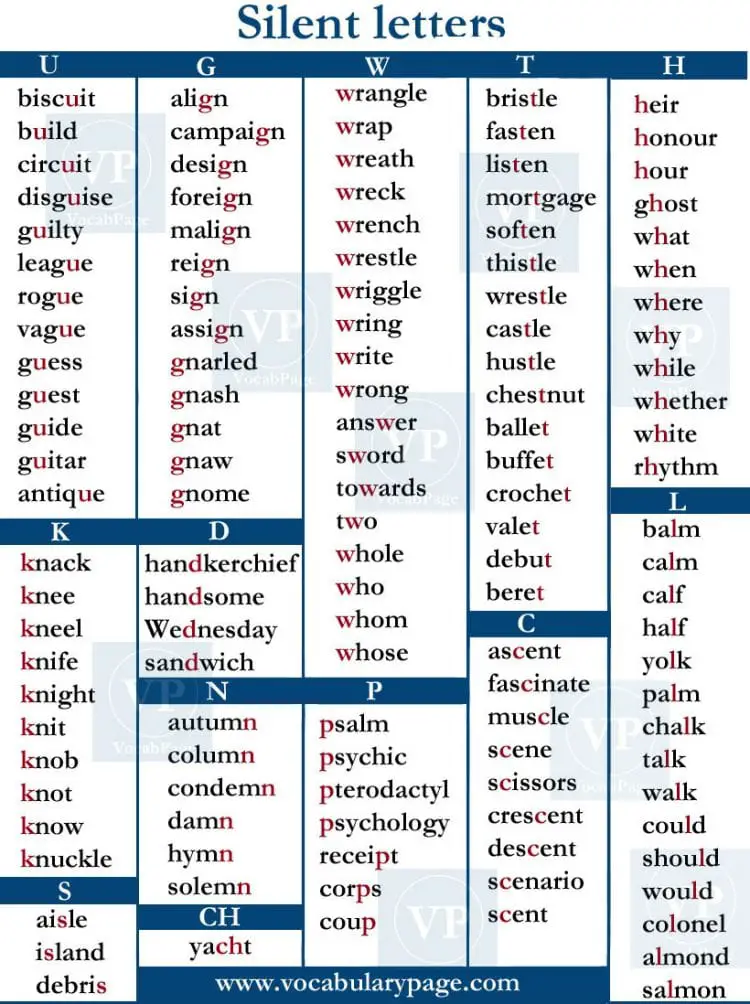
We all know that English is not an easy language to learn. It can even prove to be difficult and confusing for students who have a background in two or more languages!
For many students, however, it is the pronunciation that causes most of the problems.
It is evident that there are some very common pronunciation issues that people face when learning English as a second language. This isn’t such a bad thing, as it means we know exactly which areas to target to make these difficulties easier to overcome.
One prominent obstacle can be silent letters.
How Many Silent Letters Are There in English?
Silent letters are ones that you don’t pronounce when saying a word. They are written down, but you don’t say them out loud. There are numerous words with silent letters in the English language.
Let’s first go over the letters that are rarely, if ever, silent. These are: F, Q, R, V, and Y. In British English there can be some silent R’s, but that’s a matter of dialect.
So, if there are five letters that are not silent, then we can say that there are 21 silent letters in English. Here they are in alphabetical order, and with some examples:
Silent Letters List
Words with Silent B
Rule 1: B is not pronounced after M at the end of a word.
- limb
- crumb
- dumb
- comb
- bomb
- thumb
- climb
- tomb
- aplomb
- climb
- dumb
- jamb
- lamb
- limb
- numb
- plumb
- succumb
- thumb
- tomb
- womb
Rule 2: B is usually not pronounced before T at the end of a root word.**
- debt
- doubt
- debtor
- doubtful
- subtle
- subtleness
**A root word is the original word in its root form without any prefixes or suffixes attached e.g. doubt is the root word in doubtful, and the ‘ful’ is a suffix. Subtle is the root word, and ‘ness’ is a suffix.
Words with Silent C
Rule 1: C is not pronounced in the combination SC.
- muscle
- scissors
- ascent
- miscellaneous
- fascinate
- scenario
- abscess
- conscience
- conscious
- crescent
- descend
- disciple
- evanesce
- fluorescent
- obscene
- resuscitate
- scene
- Exceptions: Sclera, asclepiad, sclerosis, muscovado, sceptic
Rule 2: C is usually redundant before the letters K or Q.
- acquaintance
- acknowledge
- acquiesce
- acquit
Words with Silent D
Rule 1: D is not pronounced in the following common words:
- handkerchief
- Wednesday
- sandwich
- handsome
- grandson
Rule 2: D is also not pronounced in the combination DG.
- pledge
- bridge
- edge
- ledger
- dodge
- grudge
- hedge
Words with Silent E
Rule: E is not pronounced at the end of words, but instead elongates the sound of the vowel before it.
- hope
- drive
- gave
- write
- site
- grave
- bite
- hide
- debate
- desire
- excite
- kite
- love
- make
- name
- Exceptions: Giraffe, brunette, cassette, gazelle (You may be able to spot a pattern in these words; they have similar combinations in the last syllable. This shows that the exceptions are generally words with unusual stress on the final syllable – but not always! One example would be the word ‘minute’ as in the time-measuring unit.)
Words with Silent G
Rule: G is not often not pronounced when it comes before N.
- champagne
- foreign
- sign
- feign
- foreign
- design
- align
- cognac
- align
- assign
- benign
- champagne
- cologne
- consign
- gnarl
- gnash
- gnaw
- gnome
- gnomic
- high
- light
- resign
- Exceptions: Magnet, igneous, cognitive, signature
Words with Silent GH
Rule 1: GH is not pronounced when it comes after a vowel.
- thought
- drought
- through
- thorough
- borough
- daughter
- light
- might
- sigh
- right
- fight
- weigh
- weight
- Exceptions: Doghouse, foghorn, bighead (As you can see, the exceptions are generally compound words i.e. words that have been formed by combining two complete words)
Rule 2: GH is sometimes pronounced like F.
- rough
- tough
- laugh
- enough
- cough
- clough
- draught
- Exceptions: Examples from rule 1!
Words with Silent H
Rule 1: H is not pronounced when it comes after W (n.b. some speakers whisper the H before the W).
- what
- when
- where
- whether
- why
- white
- while
- weigh
Rule 2: H is not pronounced at the beginning of many words (remember to use the article “an” with unvoiced H).
- hour
- honest
- honor
- heir
- ghost
- psychology
- schedule
- scheme
- school
- vehicle
- thigh
- Exceptions: hill, history, height, happy, hereditary (Plus most other words beginning with H that are NOT of French origin – and remember to use the article “a” with voiced H)
Rule 3: H is often not pronounced when it comes after C, G or R.
- choir
- chorus
- ghastly
- ghoul
- aghast
- echo
- rhinoceros
- rhythm
Words with Silent K
Rule: K is not pronounced when it comes before N at the beginning of a word.
- knife
- knee
- know
- knock
- knowledge
- knead
- knack
- knight
- knit
- knob
- knock
- knot
- knuckle
Words with Silent L
Rule: L is not pronounced after the vowels A, O and U.
- calm
- half
- talk
- walk
- would
- should
- could
- calf
- salmon
- yolk
- chalk
- folk
- balm
- almond
- behalf
- folk
- palm
- stalk
- Exceptions: Halo, bulk, sulk, hold, sold, fold, mould
Words with Silent N
Rule: N is not pronounced when it comes after M at the end of a word.
- autumn
- hymn
- column
- solemn
- dawn
Words with Silent P
Rule: P is not pronounced at the beginning of many words using the combinations PS, PT and PN.
- Psychiatrist
- pneumonia
- pneumatic
- psychotherapy
- psychotic
- psychologist
- pseudonym
- Pterodactyl
- receipt
- cupboard
Words with Silent PH
Rule: PH is sometimes pronounced like F.
- telephone
- paragraph
- alphabet
- epiphany
- sophomore
Words with Silent S
Rule: S is not pronounced before L in the following words:
- Island
- isle
- aisle
- islet
Words with Silent T
Rule: T is not pronounced in these common words:
- Castle
- Christmas
- fasten
- listen
- often
- whistle
- thistle
- bustle
- hasten
- soften
- rapport
- gourmet
- ballet
- bristle
Words with Silent U
Rule: U is not pronounced when it comes after G and before a vowel.
- guess
- guidance
- guitar
- guest
- guild
- guard
- baguette
- biscuit
- build
- building
- circuit
- guide
- guilty
- rogue
- silhouette
Words with Silent W
Rule 1: W is not pronounced at the beginning of a word when it is before the letter R.
- wrap
- write
- wrong
- wring
- wreck
- wrestle
- wrack
- wrist
Rule 2: W is not pronounced in the following words:
- Who
- whose
- whom
- whole
- whoever
- answer
- sword
- two
List of Words with Silent Letters
- A: logically
- B: climb, comb
- C: acquire, muscle
- D: bridge, edge
- E: date, name
- G: high, sign
- H: heir, honest
- I: business
- J: hallelujah, marijuana
- K: knife, know
- L: calf, talk
- M: mnemonic
- N: damn, hymn
- O: colonel
- P: corps, pneumonia
- S: debris, island
- T: ballet, listen
- U: guess, guilt
- W: answer, two
- X: faux pass
- Z: rendezvous
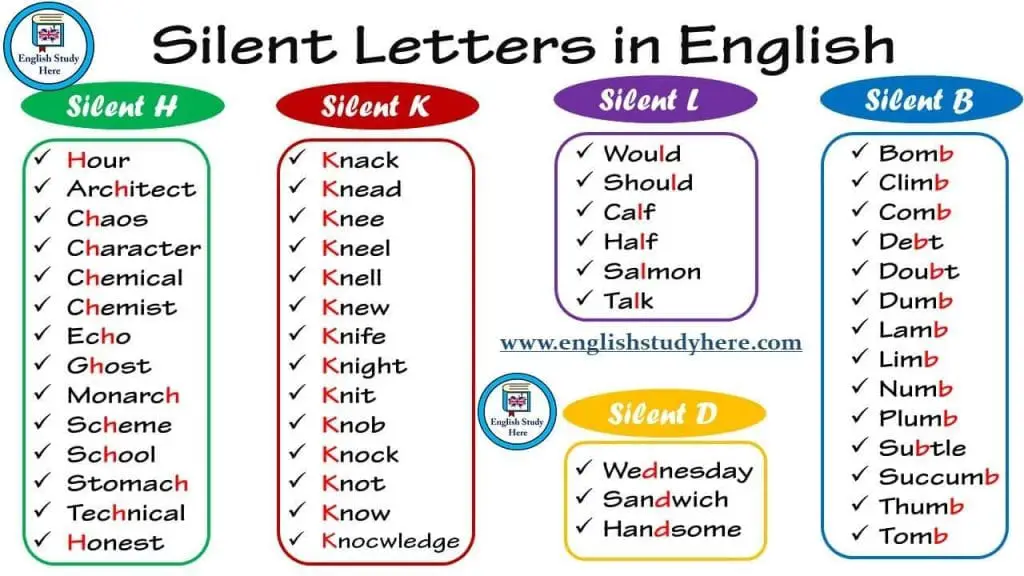
What Are Silent Letters Called?
Silent letters are just called silent letters. In some slang terms, they are also called dummy letters. There is no linguistic or phonetic name for silent letters, except silent letters.
Rules of Silent Letters
This list contains most of the common silent letters and combinations that cause difficulties for English learners. Here are the rules to help you understand when to use some silent letters, but remember there are usually some exceptions!
(Please note that this is not a comprehensive list of all the rules around silent letters, only some of the most common ones that you may come across).
More for you:
Give 10 words in which ‘g’ is silent!
Why is K silent when it comes before the letter N?
The English Alphabet – ABC in English
6 Ways to Immediately Improve Your English Communication Skills
Words with Silent Letters at the Beginning
There are over 90 words in English that start with a silent letter. Here are some of them.
- pseudoephedrine
- ptosis
- pterion
- pterygium
- psilophyte
- gnomonist
- gnomonic
- gnomonics
- gnotobiotic
- gnosticism
- gnu
- wrench
- wrested
- writing
- written
- writ
- wright
- wrought
- wroth
- wrathful
- wrangling
- wrangler
- wrangle
- wretch
- wreath
- wretched
- gnostic
- wrestling
- wrestle
- wrest
- writhe
- wryneck
- wraith
- wry
- psychrotrophic
- psychrometer
- wrist
- honest
- homage
- knurl
- heir
- knur
- psalm
- pteranodon
- wrath
- write
- wrap
- who
- wrinkle
- wren
- psychiatry
- psychology
- psychosis
- psychic
- pterodactyl
- pneumonia
- knick-knack
- herb
- honor
- hour
- gnomon
- gnome
- knight
- knee
- knob
- gnaw
- gnat
- gnarly
- czar
- aisle
- chthonic
- mnemonic
Silent Letters for Grade 1
Start with the silent letter e, because it appears in easy words.
Example:
- Cake, pie, skate, stove, plane, shoes, kite, lemon, cane.
Make an exercise where the students have to fill in the word under a picture:
C_k_ / P_ _ / S_at_ / Pl_n_ / S_o_ _ / K_t_ / L_mo_ / C_n_
Then you can ask them which letters they do not hear. You can then explain that those are silent letters, and one of them is the letter e. You can use various examples.
Silent Letters for Grade 2
Start with the letter h, and use harder examples.
Example:
- Honest, hour, school, stomach, what, when, ache.
Make sure to use words that the students know, and then show them how the words have silent letters. H is a very common silent letter, so ask them to add more examples of words that have a silent h.
- Echo, technology, where, when, chrome, character, anchor, ghost, etc.
Silent Letters for Grade 3
Use the letters t and u. These letters appear next to each other in the alphabet, and they can be silent in various places in a word.
Example:
- Castle, butcher, match, often, rustle, watch, whistle, soften, scratch.
Ask your students to write down the words when you pronounce them, see if they wrote them with the letter t. From there you can move to the letter u.
- Biscuit, guess, guitar, tongue, guard, guest, building.
See if the students have written them with the letter u. From there you can explain how various letters can be silent, and how they can appear in different places within a word.
Silent Letters for Kindergarten
The easiest silent letter is k, so start with those examples.
Example:
- Knife, knee, know, knob, knock, knuckle, knight, knot, etc.
Tell your students that the words are written with a k at the start, but the letter is not pronounced. Use examples with k, and make sure the students pronounce the words correctly.
Silent Letters gn, kn, wr list
- GN: gnaw, gnat, gnash, gnarl gnome, sign, reign, foreign, sovereign, design, campaign, align, assign
- KN: knack, knee, kneel, knife, know, knight, knuckle, knit, knob, knot
- WR: wrangle, wrap, wreath, wrench, wreck, wrestle, wriggle, wring, write, wrong
Silent Letters Before N
The two most common letters that are silent before the letter n are K and G.
- Knack, gnaw, knee, gnash, knock, align, assign, knuckle, knob, design, gnome, knife, knowledge, campaign, etc.
Silent Letters Activity
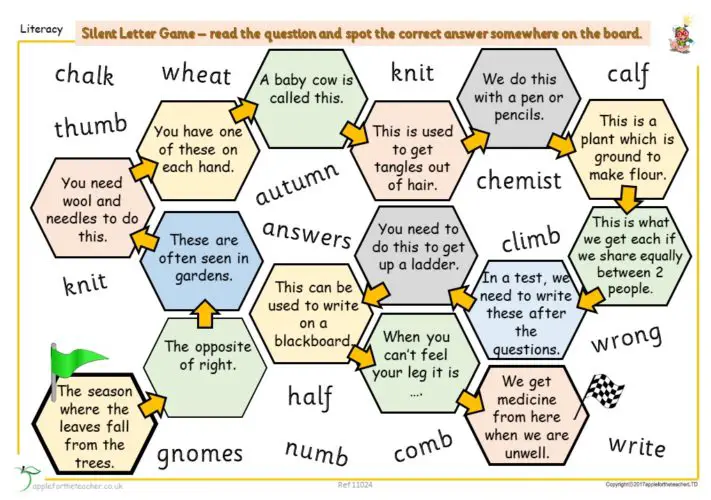
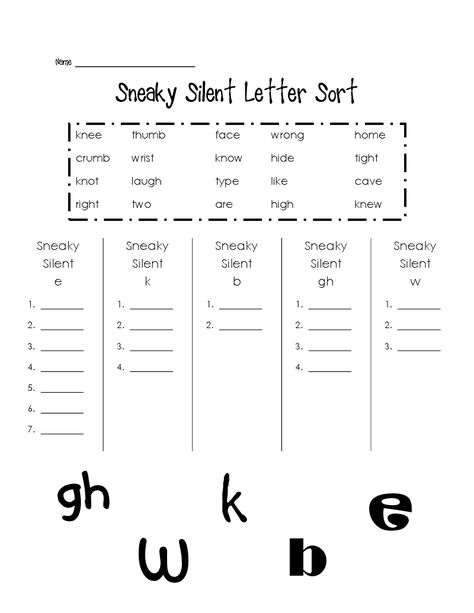
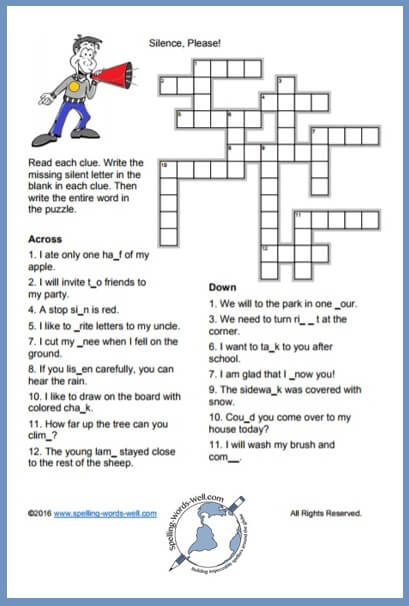
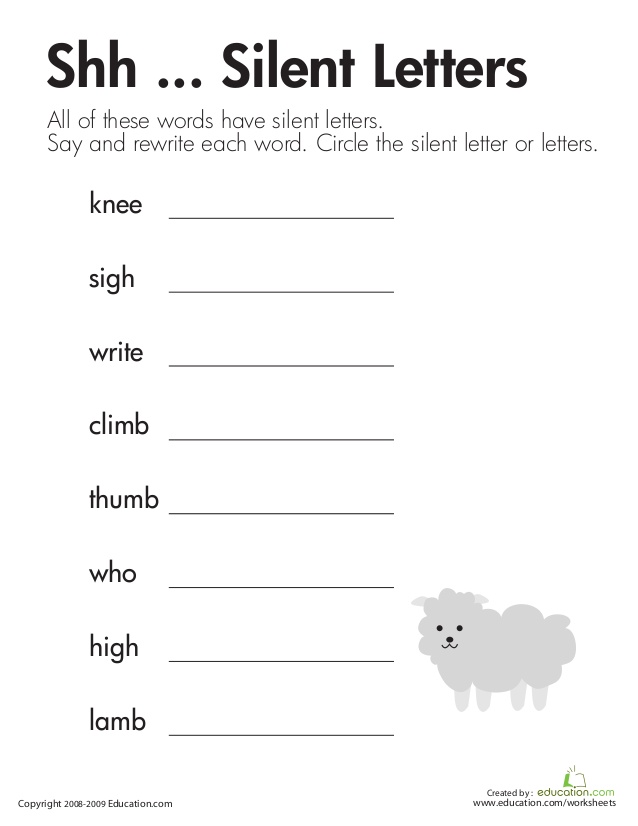
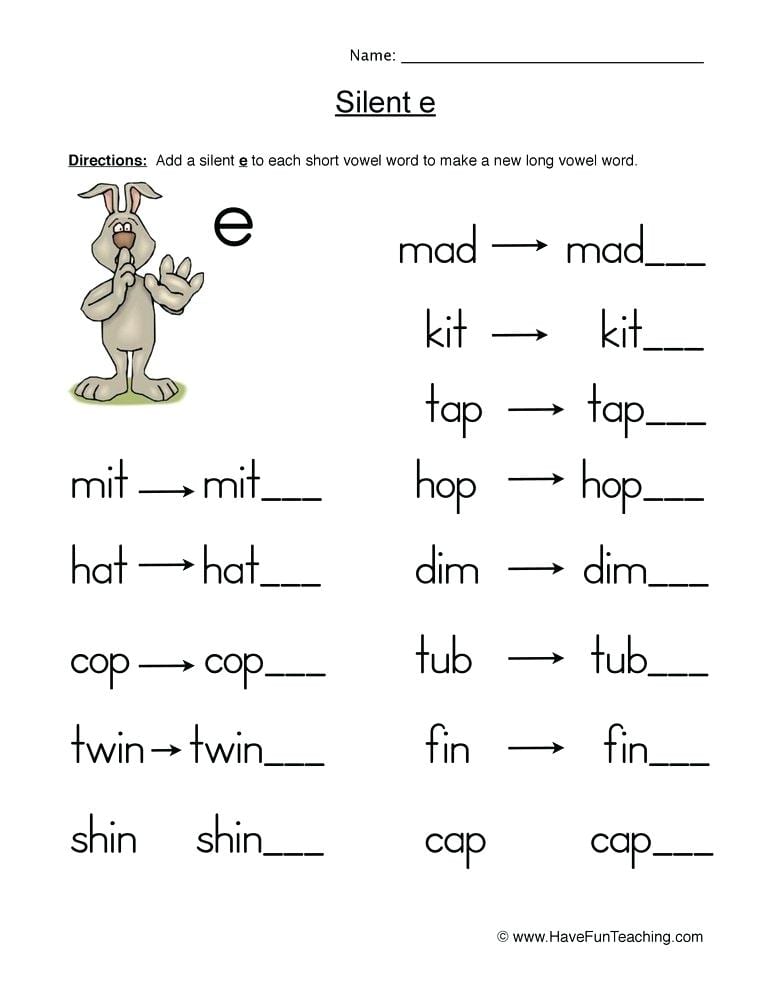
Why are Silent Letters Used in English?
You may think that silent letters can’t be all that important if they’re not pronounced, but as a matter of fact, they make a HUGE difference to the meaning of words, and sometimes, they even have the power to change their pronunciation!
🥁 When Were Silent Letters Invented?
If you look into the history of this language, you will see that about 90% of English used to be phonemic (this means that the words sounded the same as they looked). There were hardly any silent letters at all, but this soon began to change around the 15th century.
Many words from other languages were introduced into English, to make it look more Latin or French. This caused problems as the new words didn’t follow the same rules of grammar as English! That is why, even though the spelling was already fixed for those words, some letters became silent.
🥁 Why do Silent Letters Exist?
The Latin alphabet was also adapted into the English language, and so there are only 26 letters to represent approximately 41 different significant sounds. For this reason, an attempt to use combinations of letters to represent sounds was introduced, thus ensuring that all the major sounds in English were covered.
This does make silent letters quite interesting, as you can see the history of each word in the way it is spelt, and track its origins!
As time passed, pronunciation continued to change, but the old spelling was preserved by the printing press, which came to England around the Middle English period. That’s why there are words that end in a silent ‘e’, or have other silent letters in the middle, such as ‘fright’.
Now, modern day English is only 40% phonemic!
- WRITE
- KNEE
- KNOCK
- LAMB
- WRIST
- HALF
- PLUMBER
- PSYCHOLOGY
- AISLE
- DAUGHTER
More for you:
Formal and Informal Email Phrases Starting with Greetings
Why is ‘t’ silent in these words Watch, Listen, Butcher …
Now I bet you’re thinking – “I hate spelling! This will make learning English even harder!” I can assure you; it’s not that bad, really.
As I mentioned before, around 60% of English words contain silent letters, so it is important to know how to spot them, when they can be pronounced and when they cannot.
It could also cause problems if you are trying to find a word in a dictionary by the ‘sound’ of it, and not realizing that it has a silent letter in it!
Let’s use the word ‘knowledge’ as an example, if you didn’t know how to spell this word, you might look under the letter ‘N’ in a dictionary!
What are the Rules for Silent Letters in English?
Don’t worry too much, there is (sort of) a ‘solution’ ….there are some rules that explain which letters are supposed to be silent, before and after certain letters (the only ‘minor’ issue about this is that, like all English rules – there are usually some exceptions!).
Once you start practising these rules and use any new vocabulary that you learn, it will become easier to remember which letters are silent in some words, and in which words they are supposed to be pronounced.
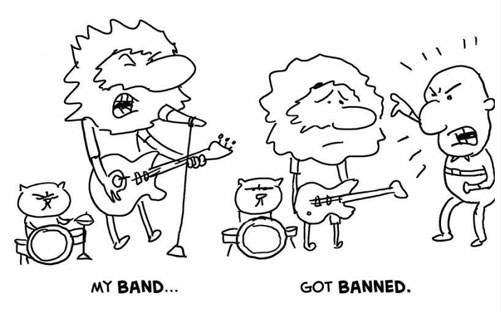
Silent letters are not there to confuse you, even though you may think so! Identifying and understanding them will undoubtedly improve your spelling, speaking and writing skills, as well as boost your confidence!
🥁 Helpful Uses of Silent Letters
They can be beneficial for readers, when having to distinguish between homophones (these are words that have the same sound, but different definitions and different spelling). Some examples of homophones are
- know/no, knot/not, their/there/they’re, band, banned and to/too/two.
Silent letters can change the pronunciation of words, even though they are silent! For example,
- sin/sign, grim/grime, cop/cope, and rat/rate.
So it is very beneficial to know where they are and when they are used, as they’ll help you to work out the meaning of the word!
The letter ‘H’, when pronounced alone, should sound like ‘aitch’, but when used at the start of most words beginning with H, it uses its pronounced sound (e.g. hotel, house, ham), BUT it is usually silent in words that are of French origin such as
- hour, honest, heir, and honour.
If Etymology (the origin of words) interests you, then you’ll find learning silent letters very fascinating, as they provide so much information about the history of words!
The magic ‘e’ is another one of course! If you add ‘e’ at the end of words with short vowel sounds, it elongates the sound of the vowel, some examples would be:
- tap/tape, mat/mate, rid/ride, con/cone and fin/fine.
More for you:
Hilarious Homophones. 50 Stupid Writing Mistakes to Avoid
Difference between Homonyms and Homographs
If you really want to improve your English and grow to love spelling, I would recommend you take an interest in the words you are learning. Try to understand the background of the words, think about how and why they’re spelt the way they are, and discover the logic behind them!
This is a great way of understanding, and in turn, remembering any new vocabulary that you learn, but it is especially helpful with silent letters.
🥁 How to Identify Silent Letters in English?
Identifying silent letters in English is not something you can do without practice. There are two ways to identify them. One is by listening to the pronunciation, and the other is finding them directly in a written text.
In order to know which letters are silent you have to know how to pronounce them. Identifying silent letters is most commonly done by listening, and then writing. When you know how the word is spoken you will know which letters are silent.
When you’ve been practicing for a while and know how to pronounce words with silent letters, you’ll be able to recognize them in a text immediately. Without knowing the pronunciation beforehand it may be hard to recognize the silent letters.
So, to be able to identify silent letters you need to practice you pronunciation. You have to be able to pronounce the words correctly. Once you’ve practiced enough you’ll be able to identify all the silent letters in written form too.
🥁 How to Teach Silent Letters?
Silent letters are very frequent in English, and there are numerous exercises and ways to teach them. Because silent letters are different and so many words have them it’s not easy to teach silent letters. You can’t just learn them by heart, so you have to develop a vocabulary and understanding.
One of the best ways to start teaching silent letters is to first make sure your students understand what they are. You need to explain that not all letters are pronounced when saying a word, and that they are only for written spelling. When your students know that you can start using various exercises to teach them how to identify silent letters.
A good exercise to start with is a written test where students have to determine which letters are silent. This is a good way for them to get used to seeing more letters in words than they have to pronounce. This is also a good way to teach silent letter because the students won’t have to pronounce the words first, which means they don’t have to be shy about speaking the words wrong.
Example:
- Determine which letters are silent in the following words:
- ascent / ledger / cupboard / knuckle / autumn / sword / guess / listen / chaos / would
When your students are finished determining the letters you can complete the exercise by checking their results. This is a great opportunity to continue with another important step in teaching silent letters. After the students have worked with written words, it’s time for them to pronounce them.
Pronunciation is the most important lesson when teaching silent letters. Before you can start practicing that it is important to prepare students. Let your students know that there are many words with silent letters, and that they have to practice in order to learn how to pronounce them.
It is often best to start by pronouncing the words you used in written exercises. Make sure the teacher pronounces the words first, and then the students follow. Teaching silent letters takes time, and practice, so give your students good examples they can follow.
Another way to continue teaching silent letters is to choose one letter and start from there. Instead of having multiple examples, you can just have one letter in different words. That way your students can practice, and expand later on.
Example:
- knack, knave, kneel, knead, knee, knew, knickers, knife, knight, knit, knob, knock, knoll, knot, know, knowledge, knuckle
K is one of the most famous silent letters in English, and a lot of students know it. This is a good starting point. From here you can continue to work with other letters.
Since k is silent in front of the letter n, you can choose other examples that are the same. This way students will be able to identify the silent letter in front of n more often. G is another letter that is silent in front of n.
Example:
- align, assign, resign, design, benign, sign, gnaw, gnome, foreign, etc.
When teaching silent letters in English always use similar examples so that your students can remember them easier. Make sure to pronounce all the words, and practice finding them in writing and saying them out loud. Teaching silent letters in English works best when combining written and spoken exercises.
🥁 Silent Letters Exercise:
See if you can figure out how many words that contain silent letters there are in this paragraph (Please note – not all the words have been used as examples in this blog, that would be too easy..!):
It is undoubtedly a tough skill to acquire, you may even consider condemning this language, with all its oddities and words that are spelt the same but do not rhyme! I hope whoever attempts to decipher and recognise silent letters is successful and manages to train their tongue to listen to the sounds, ignore the unspoken ghosts and soften their speech. Also, that they are able to talk with folk in any matter, may it be business or pleasure, with dialogue as that of a native speaker. So grab your friend’s wrist and practise until your brain feels numb! If you try hard enough, fluent you will become!
How to Explain Silent Letters to a Child?
To explain silent letter to a child you have to be patient. A child does not easily work with something as complex as silent letters. To children, a language that has extra letters you don’t read may seem stupid.
The best way to explain silent letters to a child is through examples. Depending on the child’s age and skill level they can already know something about the topic. If they don’t know a thng about silent letters, then start with some basic examples like:
- knee, knife, gnome, autumn, etc.
These are very famous examples, so first tell the child the word, and then show it written down. They should recognize that there are extra letters in written form. Then you can start explaining that those are silent letters.
Be patient and always make sure to pronounce the words correctly. Let the child repeat after you. Once they know how to correctly pronounce the word you can start explaining what silent letters are, and why they exist.
One way to bring this topic closer to a child is by comparing silent letters to similar silent letters in the child’s native language. If your native language also has silent letters, tell the child that English does too. There are many languages where the pronunciation is not the same as the written word.
If the child’s native language has no silent letter then explain why the English language does. Start by telling the child that English is not the only language that has silent letters. French is another example.
To explain silent letters to a child make sure they understand that silent letters are not unnecessary. Because English was created from other languages, and has their influence, there are multiple letters in various words to show you how they are pronounced.
The child has to understand that these letters are necessary. They have to practice proper pronunciation, and after a while the silent letters won’t seem stupid to them anymore.
Where Do Silent Letters Come From?
Silent letters come from languages that have used them over the course of history. Some languages have had silent letters since their beginning, and in others silent letters evolved over the course of history. Silent letters don’t come from one singular source.
There are multiple sources where silent letters come from. Two languages that are famous for having silent letters are French and Italian. In those languages, the silent letters denote the proper pronunciation.
In other languages, silent letters come from umlauts, which are two letters that fuse into one. In Germanic and Scandinavian languages letters like ae, sch, oe, ue, and others become ä, ö ü, or ß. These are the ancestors of silent letters.
So, silent letters come from different languages all across the world. In English the exist because other languages had a great deal of influence over English.
When were Silent Letters Invented?
🥁 Examples of the Origins of Words
- The origin of silent ‘k’ and ‘g’ in words such as gnaw, gnat, knee and knife:
These are examples of Viking words with letters that used to be pronounced, so they are still spelt the same way, but the pronunciation has changed. Although these letters are silent, they remain so that you can see their history and origin. In Sweden, they still pronounce the ‘k’ in their word for knife (kneefe)!
- Why the word island has a silent ‘s’ in it:
Apparently the word ‘island’ comes from Middle English, and was always pronounced the way it is today. It used to be spelt in a different way, without a silent letter, but the spelling was modified during the 15th century because of the word ‘isle’ that was borrowed from the French.
- The origins of the words with silent ‘gh’ like daughter, and why the ‘gh’ in enough and rough is pronounced with a /f/ sound:
This is one of the most difficult silent letters, as it is pronounced in more ways than one! This pattern is from the Anglo Saxons, other examples are dough, bright, fight and fright.
The ‘gh’ sound used to be spelt with just the letter ‘h’, and was pronounced like the Scottish word ‘loch’ – a hard sound to pronounce! When the French invaded, they modified the spelling of these words and added the ‘g’ to make ‘gh’. This combination then either became silent or pronounced with the /f/ sound.
Here is a word that might confuse you – Hiccough is pronounced ‘hiccup’! The earliest English form of this word (in 1544) evolved into what it is in modern English today, in this order: hicket, hickot, hickock, hickop, hiccup and finally hiccough.
The last word in the series (hiccough) was apparently invented because someone thought that there should be a link between ‘cough’ and ‘hiccup’! Personally, I can’t see why!
More for you:
A BIG List of Prefixes and Suffixes and Their Meanings
When do we use the suffixes -er and -or?
How Many Languages Have Silent Letters?
There are many languages across the world that have silent letters. Many of these languages have evolved and have been influenced by history. Most languages that have silent letters use the Latin Script.
- Danish, Faroese, German, French, Indonesian, Irish (Gaelic), Norwegian, Italian, Spanish, and Turkish
Some languages that don’t use the Latin Script also have silent letters. These are Chinese (Mandarin and Cantonese), Japanese, and Russian.
🥁 Who Invented Silent Letters?
Silent letters were not invented. One person, or more people, or even a while country, did not invent silent letters. The history and evolution of language caused silent letters to be a part of the English language.






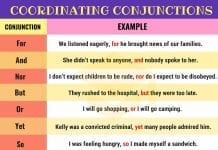

















Iam very happy to this
I argue that d is not silent in grudge. My tongue touches the roof of my mouth when saying grudge, but no so saying a word like cage.
how about budge
Hello Frank, thank you for your comment. You make an interesting point! If you continue saying cage, grudge and bed slowly, you will notice that for cage and grudge, the back of your tongue only gently touches the roof of your mouth, whereas for bed, the tip of your tongue will sharply tap the front of your palate. Quite a noticeable difference when repeated that way! I hope this helps. Nadia
I wonder if this is dialect specific? I would usually pronounce the d in grudge, dodge, hedge and budge. I definitely also pronounce the d in sandwich and handsome, and can go either way with handkerchief. I don’t think I speak any differently from others around me. But yes, this IS a very useful page.
Silent letters are called aphthong. Upon googling it this is what i found…
aphthong (plural aphthongs) (phonology) A letter or combination of letters employed in spelling a word but not pronounced. The letters “gh” in “knight” are an aphthong.
thank you to helpfull article
You are very welcome! 😊
It is very helpful to improve english
I just say thank you for helping us
Glad to help! ?
vely helpeful
I’m glad you found it helpful!
Thank you, Nadia, for helping us to understand the silent letters.
great blog!
You’re very welcome! Glad you found it useful.
you are really awesome and thanks for sharing a very informative article with us.
Thank you so much! You are awesome too!
Thank you for your contribution and hard work. Thank you very much.
Sure, we are always glad to help you!
Wow it’s literally blow my mind and i love it
A great aid when you don’t have the time to look them up yourself. THANKS so much